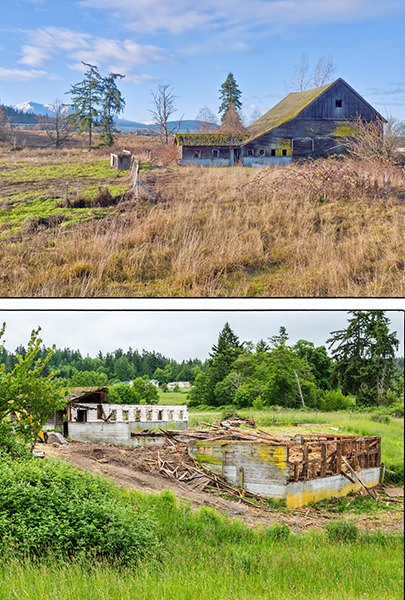Time finally took its toll on a historical barn settled between U.S. Highway 101 and Brownfield Road.
The sky visible through the shingles of the barn’s aging roof and its weathering support structure spurred co-owner of the barn Ray Fasola to knock it down. Given location of the old barn and its visibility to all those passing by, it had become somewhat of a landmark.
“I was worried about someone getting hurt,” Fasola said. “It was becoming a liability.”
At the northern end of the barn is deep drop-off covered by unstable flooring and rotten hay – a cause for concern to Fasola.
“I don’t want any kids falling down that,” he said.
Fasola owns the barn and 5.85 acres along with his brother Roger, but have put the property up for sale.
Although Fasola lives in Port Angeles, he was born in Sequim and has longtime family roots dating back to the area.
“My grandfather came here from Switzerland in the 1920s I think,” Fasola said. “I think my dad bought this place (the barn and property) around the 1940s.”
Fasola never lived on the property, but instead Fasola’s father Clarence rented the it to “cattle dealers,” he said. Livestock dealers Irvin Boyd and Fred Rice used the old barn for their cattle operation and hauling business.
Once it no longer was used as a transfer station for moving cattle, the barn eventually served for various dairy operations under Gene Edgington and later Murl Brownfield.
“They (Murl and Mary Brownfield) sold and moved to the Fasola ranch on what is now Brownfield Road where Murl dairy farmed and Mary tended her vegetable garden and beautiful flowers,” according to “Sequim: Pioneer Family Histories From 1850-1962.”
Throughout the years following its use as a dairy farm, farmers from around the area have used the barn for hay storage, Sequim resident Mary Bell said. Bell and her husband Delane maintain their own herd of cows not far from the now mostly demolished barn and recalls storing hay there, she said.
Fasola checked with officials from both the Clallam County Historical Society and county courthouse, but couldn’t find the exact year the barn was built, he said.
“I think it was built in the early 1930s,” Fasola said. “But I don’t know that for sure.”
The barn was eligible for the Washington Heritage Barn Register, but Fasola opted to not register the barn because the property is for sale and its age had begun to challenge its safety too much, he said.
Since the demolition process recently began, people have come to the property asking about the barn, expressing their own thoughts on the structure. In some instances, the reaction to the barn coming down has been somewhat contentious. For example, the door of the excavator being used to disassemble the barn was vandalized with black marker with a note denoting disappointment in the decision to demolish the barn.
But, Fasola said, in other instances people primarily have been curious in the wood and scrap material.
If you are interested in 2-inch by 6-foot cedar and fir old-growth lumber or firewood, contact 452-3550.
The property zoned mix use is for sale through Windermere Real Estate.


